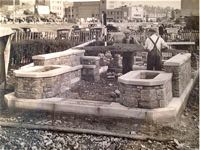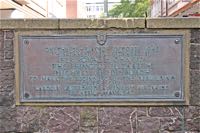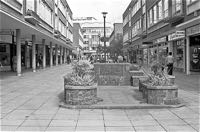
The Princesshay Commemorative Plaque
Page updated 22nd November 2015
Thomas Sharp's 'Exeter Phoenix' plan for rebuilding the city after the war recommended a new shopping precinct that would stretch from a new roundabout at London Inn Square to intersect with Bedford Street. The new precinct, which would be the first traffic free shopping street in the country, was carefully aligned to give a view of the cathedral. The feature was in the centre of the throughway of Princesshay, at the Bedford Street end. The north side of the High Street was complete by 1952, followed by Princesshay in the mid 1950's.
The rebuilding commenced when Princess Elizabeth visited Exeter for six hours on 21st October 1949–she lunched at the Guildhall before she proceeded to Princesshay, with the Mayor Maj Gen W G Michelmore. She was presented with a silver-plated screwdriver so she could complete the fitting of the plaque, in the middle of the feature. She then addressed the crowd with:
"The last time I visited this beautiful city three years ago the scars, of war were still comparatively recent, and although everything possible had been done to tidy the devastation it was yet too early to do more than talk of the rebuilding. I saw enough then to realise how much you had lost what were surely among the most senseless and unwarranted air raids that ever took place, and I am therefore, all the more pleased to preside to-day at the beginning of a new era in the city's history. If much that you loved and admired has been destroyed you have by way of recompense, an opportunity which is given to few cities. In these crowded islands we have little space to build, and it is seldom that the men of the twentieth century have a chance to show what they can do in the very centre of a town. We are apt to criticise, often I think justly, shapeless suburbs, which in some places have grown up without style or taste, and we sometimes think they represent the best the century can do. But the centre of Exeter is something quite different, and what rises here will be an example by which the architecture and planning of our generation will be judged in years to come. During the Spring and Summer husband and I travelled through a large part of the Kingdom and saw for ourselves the way in which so many of our fellow subjects lived and worked. I am disappointed that we could not come to the Westcountry, and I can assure you that my husband is as sorry as I am But I am sure you will reserve as friendly a welcome for him as you have in your kindness given me when in the years to come we return together and look on the new part of your ancient city, which will have arisen where we stand to-day. It is an occasion to which I greatly look forward, and meanwhile I ask Gods blessing on all those whose task will be to build anew and to blot out the evil marks of war. Now, to mark the beginning of their work, I have great pleasure in uncovering this tablet, and in fixing it in the position it is to occupy so that future generations may see where the rebuilding of Exeter began."
The plaque's enscription said:
"On the 21st day of October 1949
This
tablet was set here by
The
Princess Elizabeth
Duchess
of
Edinburgh
To
mark the beginning of the rebuilding
of the city
Largely
destroyed by enemy air raids
In
April – May 1942"
All Princess Elizabeth could see of the new shopping precinct were pegs in the ground, laying out the position of the street and buildings. It would be another five or six years before Exonians coud indulge their passion for shopping in the growing post war affluence of the 1950s.
The planners had great hopes for the new Britain, but the reality was poor design, a neglect of our heritage and a lack of real vision. It is a sixty year cycle of the same mistakes and neglecting the wishes of the people who actually live here.
When Princesshay was redeveloped in the 2000s, the feature and plaque were removed and the plaque put into store. The
Commemorative Plaque could have been placed on a wall somewhere in Princesshay, but neither the council, nor Land Securities have relocated it in a suitable place, and another small part of our heritage is lost to the decisions of unelected council managers who are only too eager to keep the developers happy.
Sources: The British Newspaper Archive and Exeter Phoenix by Thomas Sharp.
│ Top of Page │



